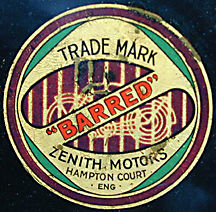 | |
| Industry | Manufacturing and engineering |
|---|---|
| Founded | 1904 |
| Defunct | 1950 |
| Headquarters | London |
| Products | Motorcycles |
Zenith Motorcycles was a British motorcycle and automobile manufacturer established in Finsbury Park, London in 1903,[1] by W. G. Bowers.[2] Automobile manufacture only lasted from 1905 to 1906. The first Zenith motorcycle was the 'BiCar' of 1903, based on Tooley's Bi-Car design, which was purchased by Zenith for its own production. The BiCar was a unique design with hub-center steering and a low-slung chassis with the engine (from Fafnir in Germany) centrally fixed.
Fred ('Freddie') W. Barnes was hired as chief engineer in 1905, and patented the "Gradua" variable-ratio belt drive transmission that year. The Gradua system simultaneously changed the diameter of the crankshaft belt-drive pulley to alter the drive ratio, while moving the rear wheel forward or back to maintain belt tension.[3] The Gradua's action was controlled by a rotating lever atop the fuel tank, and was among the first attempts to provide multiple drive ratios for a motorcycle, at a time when very simple, direct belt-drive transmission was the industry norm. Variable drive ratios proved a significant advantage in competition, leading riders of other marques to complain the Gradua gave an unfair advantage; eventually Zeniths with Gradua gears were banned from many competitions. Zenith capitalized on this ban, adding the word "Barred" to their advertising and logo. The Gradua system was replaced by the now-standard gearbox and chain transmission in 1924.
In 1914, the factory moved to larger premises, quite close to the Brooklands race track,( 5 miles away) at the old East Molesey Mill about halfway between East Molesey and Esher. As WW1 rapidly approached, the factory turned its attention to commercial sidecar outfits, ostensibly to replace the horses commandeered by the military.[4] After WW1, racing and endurance trials occupied much of Freddie Barnes' interest. Zenith motorcycles used engines from various suppliers including Precision, Villiers, Bradshaw, Martlett, British Anzani, Fafnir, and JAP.[5]
Zenith was a relatively small manufacturer, but had significant success in speed contests throughout the 'Teen and 1920s. Chief Engineer Freddie Barnes personally oversaw Zeniths in competition, and in the 1920s racing Zeniths held more 'Gold Stars' on the Brooklands racing circuit (for 100+mph laps in competition) than any other marque.[6] Racing engines of single and v-twin configuration included the most advanced designs available, including the DOHC single-cylinder JAP, the twin-cam JAP sidevalve v-twin, the Martlett OHV 1000cc v-twin, the Blackburne OHV 1000cc v-twin, and the JAP KTOR and JTOR OHV 1000cc v-twins.[7] Riders included 'Ted' Baragwanath, Bert LeVack, Owen Baldwin, H.M. Walters, and Joe Wright.
In the 1931 Zenith declared bankruptcy due to the Depression, although 'Writers of Kennington', a principal Zenith dealer, purchased the name and restarted production at the Hampton Court factory in Surrey on the river and immediately adjacent to the Hurst Park horse racing venue. The Second World War interrupted production again, and Zenith finally ceased production in 1950.[8] The last Zenith models of 1947-1950 used JAP 750cc sidevalve v-twins, and were basically the same models as produced before WW2.
- ^ The Motorcycle, 'Milestones of Design', London, Sep.15, 1937
- ^ VMCC Bulletin, Letters, January 1969,
- ^ The Motor, Sep. 26th 1905
- ^ "East Molesey Mill".
- ^ "Zenith Motorcycles". Retrieved 14 August 2008.
- ^ Brooklands Bikes in the Twenties, Hartley, 1980, Argus Books, Watford, ISBN 0-85242-620-8
- ^ The Vintage Years at Brooklands, 1968, Bayley, Goose&Son, Norwich, ISBN 0 900404 00 0
- ^ The Motorcycle, 'Milestones of Design', London, 15 September 1937